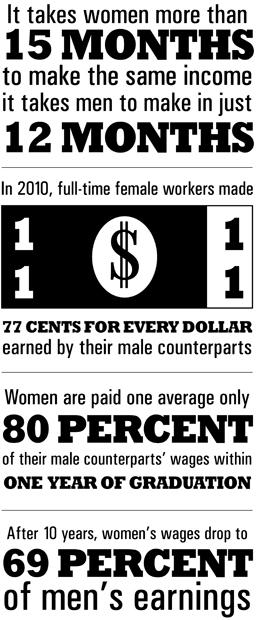
Marc Renteria, 22, a junior kinesiology major, and his Women, Work and Family class group build two ramps: one with hurdles and the other completely flat. The project shows the uphill battle for women in the workforce compared to the easy incline for men.
As stated on the National Women’s Law Center (NWLC), it takes women more than 15 months to make the same income it takes men to make in just 12 months.
“In our installation the ramp will be bigger for women because they have a longer journey of 15 months while men have 12 months,” Renteria said. “The woman will also be wearing a backpack, have a toddler next to her and will be carrying a baby.”
This installation is just one of six on campus by the Women, Work and Family course, showing various aspects of the gender wage gap as part of Equal Pay Day. The installations will be displayed on campus from April 22 to May 3 to raise awareness about equal and fair pay.
Professor Shira Brown, director of the women’s resource center and gender and women’s studies professor, applied for and received a $5,000 grant from American Association University of Women (AAUW). The university went to different colleges around the country to publicize the gender wage gap.
“It’s clearly a huge problem that requires a lot of focus and AAUW does a great job with research and making sure students are involved,” Brown said. “They allow women to learn tools and not be victims of the gender wage gap.”
In 2010, full-time female workers made 77 cents for every dollar earned by men, a gender wage gap of 23 percent, according to the Institute for Women’s Policy Research.
Ricky Manoff, a professor in the gender and women’s studies department who teaches the course, said the goal is to improve the workforce and increase the resources for a more equal climate within it.
“Right now the reality of family and maintaining of family doesn’t have to be recognized in the workplace and puts a burden on women and children,” Manoff said.
Manoff also said this issue is worse for women with children and even worse for people of color which can be devastating for families.
“I think it is extremely important to be aware and put an end to the devalued work, low pay work, women do,” she said. “Sixty percent of workers make less than $14 an hour which means there are a large number of Americans living on the poverty line and families that are food insecure.”
The grant allows each of the six groups to have a $450 budget for materials needed to complete the installation projects.
Jackie Adame, 19, a sophomore child development major, said her group focuses on changing the mindset of how people view women from childhood to adulthood.
“We are planning on having two pathways, one of which being the reality of the inequality and stereotypes women face on a daily basis and the other path is the correction of how everyone should be treated as equals,” she said.
According to Adame, each pathway has a series of photos with a caption describing the scene. There is also a scrapbook where individuals can share their personal experiences.
Briana Ponte, 19, a sophomore psychology major, said her group’s installation focuses on a three different families: a single mother with a child, a single father with a child and the typical family with a mother, father and child.
“It is important to show how the gender wage gap affects everyone,” she said. “Many single mothers don’t have money to put their children in private schools or daycares and may not have time to be with their families because they are working to provide.”
Two students in the course will be representing the university at the AAUW National Conference for College Women Student Leaders in Washington, D.C. on May 30 through June 1 where the students will be giving a presentation of the class projects.
Renteria said having a daughter makes him think about the issue, because he does not want her to be treated unfairly.
“I feel like I need to be more knowledgeable about the issue and more female students should fight for what they have earned because if they don’t fight no one will notice and it won’t be changed,” he said.
AAUW also did a study on the gender wage gap for college graduates. According to the National Organization for Women (NOW), women are paid on average only 80 percent of their male counterparts’ wages within one year of graduation. After 10 years, women’s wages drop to 69 percent of men’s earnings.
Brown said it is important students negotiate their first salary to really try and put an end to the wage gap.
“Whatever salary you negotiate will impact your future, benefits and bonuses because when you go to your next job they will ask what you made previously,” she said. “Go in confident knowing your worth.”





